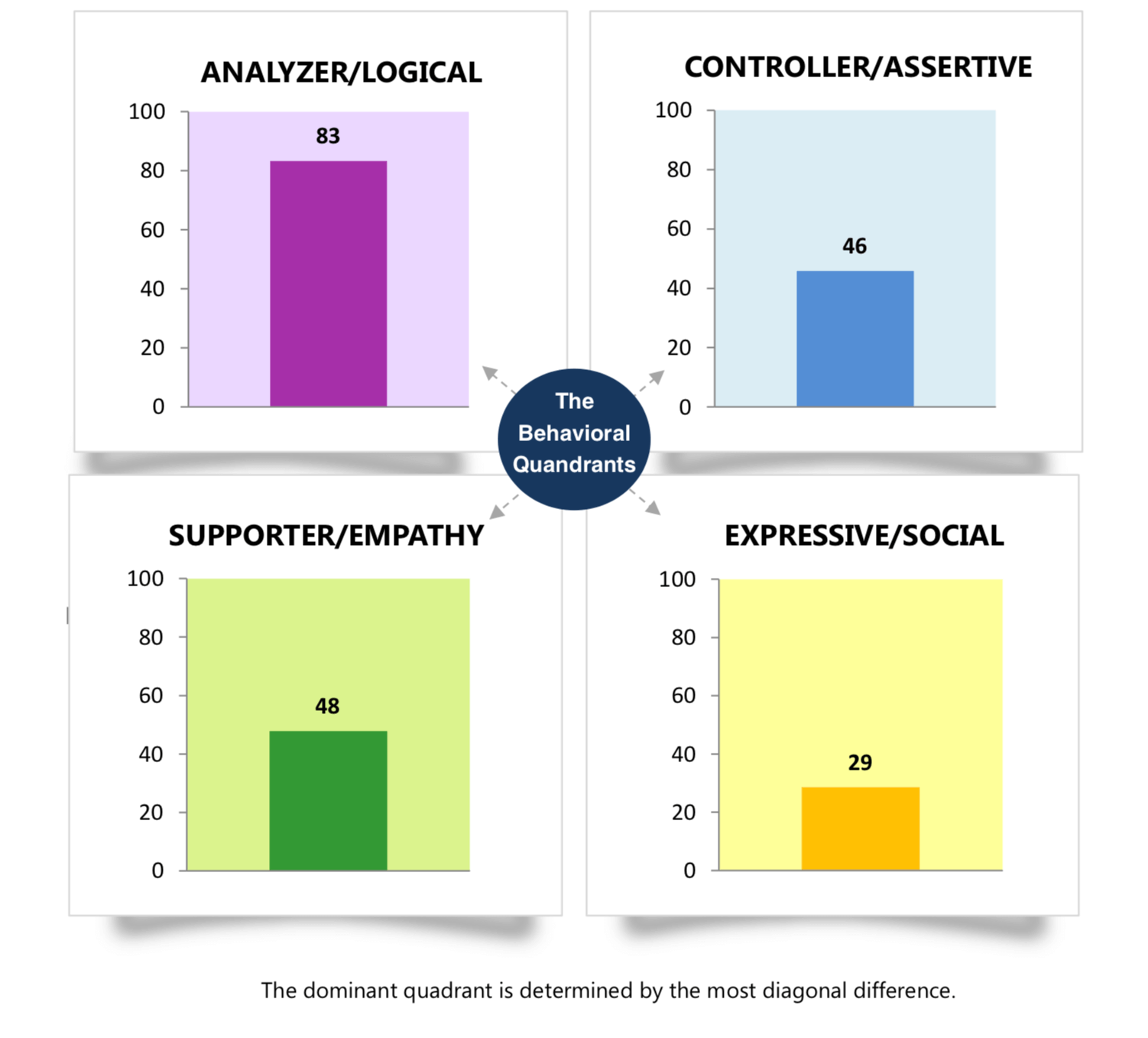The Behavioral Quadrants
Predict the Role a Person is Best Suited for With our Behavioral Quadrants
The Behavioral Quadrants
The behavioral quadrants were first noted by Hippocrates, the Greek Physician and Philosopher 2,400 years ago. Today they are used by many testing companies. The name of each quadrant changes from company to company. One company named their quadrants after four different animals. Regardless of the names, the drives are exactly the same.
The behavioral quadrants are four very basic drives in people that make up a neat useful package. I say basic because each one of these drives is made up of several other traits. For example, one of the quadrants I call the “Expressive/Social” is made up of Talking, Warm and Social, Calling Comfort and Impulsive. The other three quadrants are Supporter/Empathy, Analyzer/Logical and Controller/Assertive.
These quadrants are very useful as they predict what type of work a person will be the most suited to, most enjoy doing and what type of behavior they are likely to have. The seventeen individual aptitude traits are good for getting down to specific predictions of how a person is likely to behave, but with so many traits a basic overall prediction can get lost in the details. The quadrants give you a general idea of how a person will behave and think and from this you will find it easier to get into more detail if you need to.
Book An Appointment
Ready to Take the Next Step in Data-Driven Hiring?
Learn about the Assessments that will help you Hire Top performers
Talk With Us Now
Already set up with our Assessments?
Need Help Reviewing Candidate Results?
Call now or schedule an appointment for a Free Consultation
(833) 332-8378
On the page after next, there is a sample of a Wimbush Assessment quadrant result. You will notice the sample description of the person under the title says, “BEHAVIOR IS A CONTROLLER/ASSERTIVE TYPE.” This person is strongest on the top right quadrant. It is not uncommon for someone to have two strong quadrants like this sample but most of the time a person will have just one main quadrant.
I am about to refer to diagonally opposite quadrants, which means quadrants that are in opposite corners. For example, the Analyzer/Logical quadrant is diagonally opposite to the Expressive/Social quadrant. See page 86.
The old rule that one’s greatest strengths are their greatest weaknesses applies directly to the quadrants. The quadrant diagonally opposite to the person’s dominate (or strongest) quadrant will almost always be the weakest quadrant. In fact, this should be considered when the quadrants are not clear. The sample on the page after next has two weak quadrants on the left and the diagonal opposite quadrants on the right are the strong ones.
Sometimes the dominate quadrant does not have the highest number. But the dominate quadrant will always have the greatest diagonal difference.
When the two highest are diagonally opposite, this is most likely an attempt on the candidate’s part to cover up weak traits. It is rare for diagonally opposite, quadrants to both be highest of the four. If the second and third strongest quadrants are almost equal to each other, this is quite common and not an indication of anything inconsistent.
Each quadrant is made up of several traits. These traits can be found on the result charts that go with the quadrants. The Wimbush Assessment results give two related charts: One for “Top Quadrants” and one for “Bottom Quadrants”. They are color coded and match the color of the quadrant diagram for easier recognition.
It is important to understand the quadrants are relative to each other and their research is based on real people with real behaviors. Therefore, you could have the Analyzer/Logical quadrant (grey color coding) showing a 0, but when you look up the grey related traits in the “Top Quadrants” chart you may see some Analyzer/Logical traits as high as 30.
In this example, the candidate is in the Analyzer/ Logical quadrant and neutral in the Controller/ Assertives & Supporter/ Empathy Quadrants

These quadrants are well known among those in the personality testing field even though they may be labeled or named differently. And there are many testing groups in the world who just measure the quadrants. Some will use just 20 questions to do it. Unfortunately, someone can go to a workshop and do this mini test and be told inaccurately his or her dominate quadrant. The person is left in confusion or not impressed. The WIMBUSH-SL uses about 155 questions.
Most people will be predominately strong in just one quadrant and very weak in the diagonal opposite one and average on the other two. However, some people will be strong in two quadrants and weak in the other two diagonal ones. Remember when I say strong in a quadrant, I mean the person is comfortable and interested in doing those behaviors and not necessarily competent in those behaviors.
I have noticed for years now how people seem to be romantically attracted to those of the opposite quadrant. Most people marry someone of the opposite quadrant or close to it. Unfortunately, that is not enough to guarantee a good marriage but it is at least a start. Business partners or even subordinates make good team partners when the quadrants are opposite. One person is strong in one area and the other strong in the opposite area making the team stronger. One problem people can have with this is becoming critical of the other for not being as strong as they are in their quadrant.
One of the main advantages of the quadrants is selecting the best job functions for people. I will list below the quadrant and then the type of work this person is likely to enjoy DOING for a long time and likely to do it well.
Analyzer/Logical: (Also known as an Analyzer, Melancholy or Thinkers.)
Best Suited for:
- Accounting
- Engineering
- Estimating
- Administrating
- Programming
- Analyzing systems
- Fixing machines
- Technical work
- Making things
- Installing
- Driving
- Arts
These people tend to be interested in being methodical, organizing things, being thorough, being exact, being structured, and paying attention to detail. They usually would rather not focus on the big picture, take risks, be flexible and they tend to say the bare minimum and make phone calls only if they have to (sometimes these people talk a lot to make sure you understand all the minor details).
In a team, this person will want to remain quiet and try to organize or systemize things with an emphasis on accuracy.
Controller/Assertive: (Also known as the Driver, Choleric or Director.)
Best Suited for:
- Leading people
- Leading teams
- Managing projects
- Managing salespeople
- Running businesses
- Representing people in court
- Persuasive selling
- Closing sales
These people tend to be interested in getting things done (especially their own way), taking control of other people, winning games, speaking up, stating their opinions, asking for money and confronting people.
These people are usually poor at caring about pleasing others outside the people who are close to them. They are also usually poor at listening, having patience, teaching one on one and praising others.
In a team this person wants to run the meetings and make the decisions.
Supporter/Empathy. (Also known as the Supporter, Amiable, Phlegmatic or Relater.)
Best Suited for:
- Administrating
- Nursing
- Teaching one on one
- Apprenticing others
- Serving customers
- Helping solve problems
- Assisting health care professionals
These people tend to be interested in pleasing and caring for others, reconciling differences, working out disagreements, smoothing people, supporting others, helping, consensus building and keeping the peace.
These people are usually poor at asserting themselves, getting involved, pushing to get things done if it may upset someone, controlling others even when it is important, standing up to negativity, disciplining others and taking charge.
In a team they will tend to want to get agreements between those involved.
Expressive/Social. (Also known as the Expressive, Socializer, Sanguine or Promoter.)
Best Suited for:
- Promoting
- Networking
- Lecturing
- Teaching groups
- Politicking
- Public relation handling
- Announcing
These people tend to be interested in talking about their interests, having lots of friends, talking about problems, discussing their opinions, being fashionable, going to social events, making lots of phone calls, talking at length on the phone, small talk, discussing the big picture and repeating themselves.
These people are usually poor at listening, doing paperwork, structuring things and being exact about details.
In a team they are good at announcing or expressing information.

